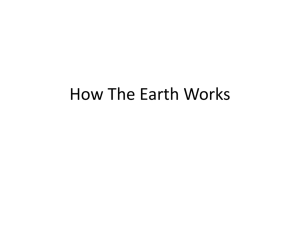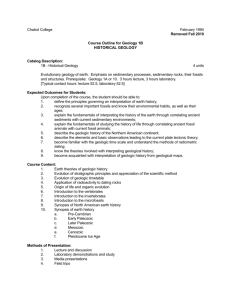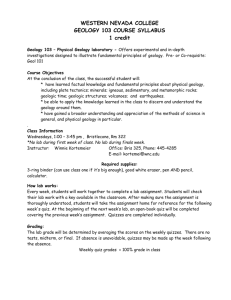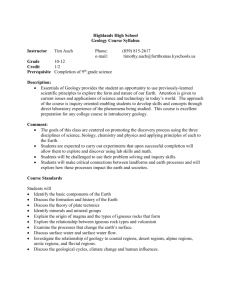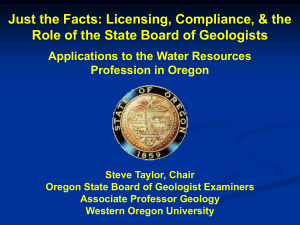In the study of mineralogy, know the general approach of each
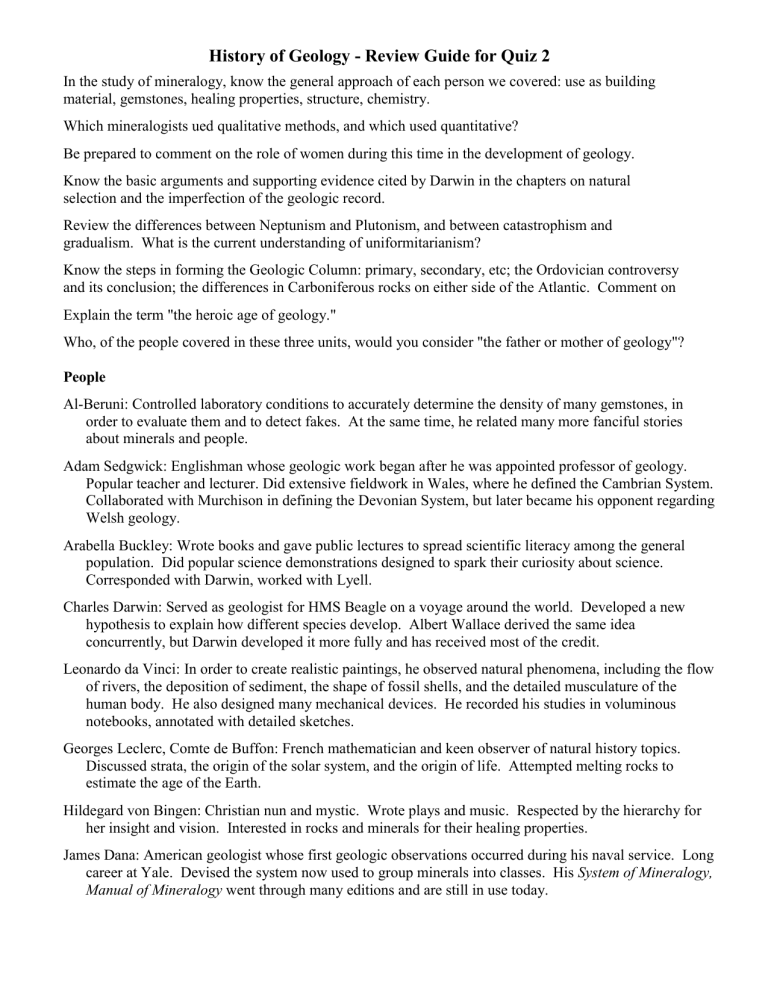
History of Geology - Review Guide for Quiz 2
In the study of mineralogy, know the general approach of each person we covered: use as building material, gemstones, healing properties, structure, chemistry.
Which mineralogists ued qualitative methods, and which used quantitative?
Be prepared to comment on the role of women during this time in the development of geology.
Know the basic arguments and supporting evidence cited by Darwin in the chapters on natural selection and the imperfection of the geologic record.
Review the differences between Neptunism and Plutonism, and between catastrophism and gradualism. What is the current understanding of uniformitarianism?
Know the steps in forming the Geologic Column: primary, secondary, etc; the Ordovician controversy and its conclusion; the differences in Carboniferous rocks on either side of the Atlantic. Comment on
Explain the term "the heroic age of geology."
Who, of the people covered in these three units, would you consider "the father or mother of geology"?
People
Al-Beruni: Controlled laboratory conditions to accurately determine the density of many gemstones, in order to evaluate them and to detect fakes. At the same time, he related many more fanciful stories about minerals and people.
Adam Sedgwick: Englishman whose geologic work began after he was appointed professor of geology.
Popular teacher and lecturer. Did extensive fieldwork in Wales, where he defined the Cambrian System.
Collaborated with Murchison in defining the Devonian System, but later became his opponent regarding
Welsh geology.
Arabella Buckley: Wrote books and gave public lectures to spread scientific literacy among the general population. Did popular science demonstrations designed to spark their curiosity about science.
Corresponded with Darwin, worked with Lyell.
Charles Darwin: Served as geologist for HMS Beagle on a voyage around the world. Developed a new hypothesis to explain how different species develop. Albert Wallace derived the same idea concurrently, but Darwin developed it more fully and has received most of the credit.
Leonardo da Vinci: In order to create realistic paintings, he observed natural phenomena, including the flow of rivers, the deposition of sediment, the shape of fossil shells, and the detailed musculature of the human body. He also designed many mechanical devices. He recorded his studies in voluminous notebooks, annotated with detailed sketches.
Georges Leclerc, Comte de Buffon: French mathematician and keen observer of natural history topics.
Discussed strata, the origin of the solar system, and the origin of life. Attempted melting rocks to estimate the age of the Earth.
Hildegard von Bingen: Christian nun and mystic. Wrote plays and music. Respected by the hierarchy for her insight and vision. Interested in rocks and minerals for their healing properties.
James Dana: American geologist whose first geologic observations occurred during his naval service. Long career at Yale. Devised the system now used to group minerals into classes. His System of Mineralogy,
Manual of Mineralogy went through many editions and are still in use today.
James Hutton: Scottish farmer and naturalist. His Theory of the Earth was the first comprehensive book of geological thought, although he didn't use the word much. He championed the idea of Plutonism - that internal heat drives surface processes. He will forever be associated with Siccar Point on the east coast of Scotland, where he found what he considered incontrovertible evidence of the vast age of the Earth.
Said: I see "no vestige of a beginning, no prospect of an end"
Leonardo da Vinci: Studied nature in order to faithfully represent the world in his art. Recorded his observations in voluminous notebooks, with detailed sketches. Left notes on architecture, weapons, and machinery. His geological notes include deductions about fluid flow in rivers, the transportation and deposition of sediment, and the nature of fossils.
Mary Anning: Discovered the first Plesiosaurus and the best (to date) Ichthyosaur skeletons. Almost entirely self-educated. Professional fossil collector who sold her work to museums and scientists. No publications, and a female of the working class, so her contributions were long neglected, but recently she has gained fans and has figured in books and dramas for people of all ages.
Nicolaus Steno: Concentrated on geology for ~ three years, then moved on. He was the first to assert that fossils are anatomically identical with parts of living organisms, and recognized that the change from organic to crystalline requires a long passage of time. Discussed the deposition of sediment and stated the principles of superposition and original horizontality. Wrote and illustrated the first known geologic history of a region in Tuscany, Italy.
Pliny the Elder: Politician, military officer, and scholar during the Roman Empire. Prolific writer on varied subjects: history, biography, grammar, drama. His Natural History covered properties and uses of metals, stones, and gems. He died while observing the eruption of Vesuvius in 79 CE.
Roger Bacon: Stressed the importance of experiments in scientific inquiry. Unlike many of his time, he saw no conflict between his studies and his faith; in fact, he believed that understanding the world leads to an understanding of God. Publications covered math, optics, astronomy, and calendars.
Sir Charles Lyell: Wrote Principles of Geology - the first geology textbook, which was reissued in many new editions over the years. Built on the work of Hutton and Playfair. He subscribed to a rigid view of uniformitarianism, where all processes occur gradually and at a constant rate through time.
Sir Roderick Murchison: Scottish geologist who worked in many places: England, Wales, Scandinavia,
Russia. With Sedgwick he defined the Devonian System. He spent years with rocks of the Silurian
System in Wales, later disagreeing vehemently with his former colleague, until he was finally forced to admit that he had erred. After he and Sedgwick had died, Lapworth solved the conflict, which had continued through their biographers, by defining the Ordovician System for the disputed rocks.
Theophrastus: Pupil and successor to Aristotle, he wrote the first descriptive classification of non-organic substances. On Stones divided material into groups based on differences of behavior and appearance.
A few can be matched to modern names. This work records the first metallurgic process: extracting mercury from cinnabar.
William Bragg: English mathematician and physicist who focused on the nature of radiation. Built a spectrometer to study crystal structure by X-ray diffraction. Worked with his son, and together they received the Nobel Prize in Physics. They formulated the equation now called Bragg's Law.
William Thomson, Lord Kelvin: Irish mathematician and physicist. Known for his studies in thermodynamics. He applied physics to the cooling of the Earth to estimate its age. Also hypothesized that life reached Earth in meteorites ( panspermia )


